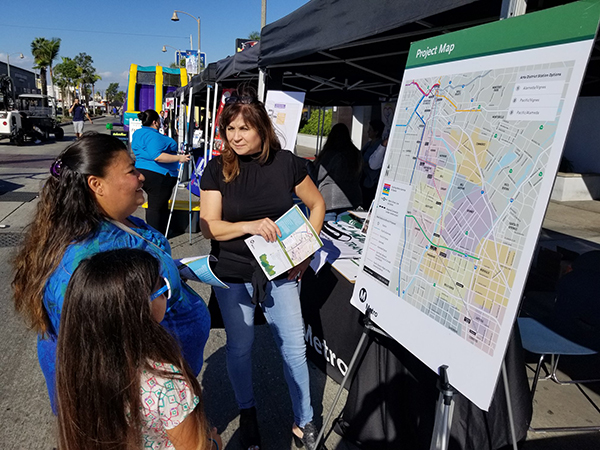By Arnold Adler
Contributing Writer
LOS ANGELES — The Metropolitan Transportation Authority will conduct three virtual public hearings this month to get input on its planned commuter light rail through 12 Southeast Los Angeles County communities.
The hearings will discussion a draft environmental impact statement released July 30 to officials and the general public.
Designated as the West Santa Ana Branch Corridor, the route would go through Artesia, Cerritos, Bellflower, Paramount, Downey, South Gate, Cudahy, Bell, Huntington Park, Vernon and the unincorporated Florence-Firestone community to Union Station in downtown Los Angeles.
The MTA staff will compile and consider all public comments in developing their recommendation to present to the MTA Board of the Directors later this year. The board will make the final decision later this year on which of several alternatives, to take, an MTA spokesperson said.
The report is designed to provide the community with information on potential environmental impacts and mitigations, potential benefits of the project and the decision-making process used by the MTA.
The draft report includes detailed information on project alternatives as a way to enhance public participation and good governance,” the MTA spokesperson said.
July 30 was the beginning of a 45-day public review and comment period, which ends Sept. 13. During that period, the public can learn more about the project and provide feedback for staff to consider.
“The rail line aims to meet priorities set out in the MTA Vision 2028 strategic plan to offer high-quality mobility options and outstanding trip experiences, while enhancing communities and lives in one of the densest corridors of Los Angeles County, with an estimated 1.4 million residents and 618,500 jobs,” the spokesperson said.
During the environmental process, MTA staff will be studying four alternatives:
The first alternative links Los Angeles Union Station with the Pioneer Station at Pioneer Boulevard and South Street in Artesia. The line is 19.3 miles and includes 11 stations.
Alternative 2 starts at the 7th Street and Metro Center in downtown Los Angeles and goes to the Pioneer Station, a total of 19.3 miles with 12 stations.
Alternative 3 links the Slauson Avenue Blue Line station and the Pioneer Station, traveling 14.8 miles with nine stations.
Alternative 4 starts at the Glenn Anderson (105) and goes to the Pioneer Station, a distance of 6.6 miles with four stations.
Alternative 1 has two additional suboptions under consideration, one of which would end at Union Station, while the other would travel through Little Tokyo with an additional station there.
The MTA staff is currently recommending Alternative 3, which would serve about 15 miles of the southern phase of the corridor and would offer service to downtown L.A. via the A Line. That alternative would be pursued as long as it is determined to meet the project’s purpose and funds are available to build it.
The virtual hearings will include a brief presentation by MTA staff after which those listening in will be given the opportunity to provide comments.
The first virtual meeting will be from 6 to 8 p.m. Aug. 19 with a zoom link at http://tinyurl.com/3f88s7hf and interpretation offered in Spanish, Korean and Japanese.
The second virtual meeting will be from noon to 2 p.m. Aug. 24 with a Zoom link at http://tinyurl.com/4asvr4pz. Interpretation will be provided in Spanish.
The third virtual meeting will be from 10 a.m. to noon Aug. 28 with a Zoom link at http://tinyurl.com/4df3b3rk.
The call-in number for all three meetings is (213) 338-8477.
City officials from Bellflower and Paramount commented on the proposed rail line.
“We have started to review the 1,400-page report,” said Leonard Gorecki, Bellflower’s assistant city manager.
He said the city is concerned about the bicycle and pedestrian path along right-of-way owned by the MTA.
“We have an agreement [with the MTA] for the bike path,” Gorecki said. “It will be up to [the MTA] to design a rail corridor which doesn’t interfere with the bike path.”
Paramount Mayor Brenda Olmos was optimistic about the plan.
“The city of Paramount sees a lot of potential, if done correctly, for the West Santa Ana Branch light rail project to get us away from clogged freeways and connect us to the rest of the county,” she said.
“We have the population and the jobs, and it’s only right that our tax dollars come back to serve us with clean, safe transit where we live.
“Our staff is still digesting the [report], but we, as the city, want to make sure construction and operational disruptions are minimized if not zeroed out. We’ll do our part, and we want to get residents involved through the upcoming virtual meetings and giving public input.
“It’s important that we advocate for the best possible MTA rail line to take us all the way to Union Station in downtown Los Angeles without having to transfer lines or trains.”
For more information, visit the MTA’s website at http://MetroWSAB.com.












